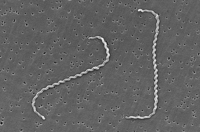
Photo from wikipedia
Background Leptospirosis causes significant economic losses and is an occupational risk in the swine industry, especially in developing tropical regions where social and geoclimatic conditions are favorable for the transmission… Click to show full abstract
Background Leptospirosis causes significant economic losses and is an occupational risk in the swine industry, especially in developing tropical regions where social and geoclimatic conditions are favorable for the transmission of this disease. Although vaccination can reduce infection risk, efficacy is diminished if local genetic and antigenic variants of the pathogen are not accounted for in the vaccine. Identifying and characterizing strains that circulate in different populations is therefore critical for public health mitigation practices. Methodology/Principal findings Our study was conducted on a rural breeding farm in Ecuador, where we identified, for the first time, Leptospira santarosai in the kidneys, testicles, and ejaculate of a vaccinated boar. L. santarosai was detected with a PCR assay that targets lipL32, and identified by target MLST gene sequencing using an Oxford Nanopore MinION sequencer. Conclusions/Significance As L. santarosai is pathogenic in other livestock species and humans, our finding highlights the need to evaluate the prevalence and epidemiological significance of this pathogen in pigs. In addition, further studies are needed to identify and characterize local serovars that may impact diagnosis and vaccination programs to better control leptospirosis in pigs and spillover into the human population. Author summary Leptospirosis poses a significant threat to human and animal health. In tropical countries, leptospirosis is very common, and responsible of economic losses in the livestock industry. In peridomestic and rural farms, the spillover of leptospira to humans is particularly likely as humans live and work in close proximity to animals. Although animal vaccination can reduce risk of infection, efficacy is diminished when local variants are not included in the vaccine. This report describes, for the first time, the presence of Leptospira santarosai in the reproductive tract of a vaccinated domestic boar from a rural farm in Ecuador. We detected the pathogen in its semen and urine, and despite no tissue damage, was observed in the kidneys, testes or epididymis. The farm veterinarian reported reproductive problems in sows inseminated with the semen from this boar. Our results highlight the importance of recognizing locally circulating serovars and species so that they can be included in vaccines to prevent infection and disease. Effective control of leptospirosis in livestock not only reduces economic losses for breeders, but also reduces the risk of infection and disease in humans.
Journal Title: PLoS ONE
Year Published: 2022
Link to full text (if available)
Share on Social Media: Sign Up to like & get
recommendations!